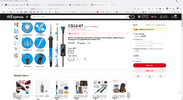crustysolder
New Member
Hi,
I have an old Weller soldering iron which seems to have eaten the tip (as if it's melted), I suspect something may have expired as I'm sure these irons usually click when in use, but I don't recall feeling or hearing this for a while.
I don't know much about the model, just that it says WTCP50 on the front of the main unit. I normally use a chisel tip as I mainly do just regular soldering (normal components, wiring, etc) and find it supplies the best heat for this purpose, however I have no idea if it's running at the optimum temperature for this kind of work, I acquired the iron second hand.
I'm thinking I probably need to consider replacing the piece that holds the tip on as well as a new tip (the tip has a number stamped on the side - 651 - and a 6 on the end), in case something like a thermostat has failed (I don't actually know how this iron regulates temperature).
When looking at replacement tips I've seen a lot of the newer style which look like a fat biro, with what looks like a rubber grip very close to the tip, this style may help me a lot as my hands tend to shake a bit when trying to concentrate on holding the iron steady! Would I need a new setup for that or can one be fitted to this iron? Is there any other information required in order to find the correct parts I need? Thanks very much!
I have an old Weller soldering iron which seems to have eaten the tip (as if it's melted), I suspect something may have expired as I'm sure these irons usually click when in use, but I don't recall feeling or hearing this for a while.
I don't know much about the model, just that it says WTCP50 on the front of the main unit. I normally use a chisel tip as I mainly do just regular soldering (normal components, wiring, etc) and find it supplies the best heat for this purpose, however I have no idea if it's running at the optimum temperature for this kind of work, I acquired the iron second hand.
I'm thinking I probably need to consider replacing the piece that holds the tip on as well as a new tip (the tip has a number stamped on the side - 651 - and a 6 on the end), in case something like a thermostat has failed (I don't actually know how this iron regulates temperature).
When looking at replacement tips I've seen a lot of the newer style which look like a fat biro, with what looks like a rubber grip very close to the tip, this style may help me a lot as my hands tend to shake a bit when trying to concentrate on holding the iron steady! Would I need a new setup for that or can one be fitted to this iron? Is there any other information required in order to find the correct parts I need? Thanks very much!


